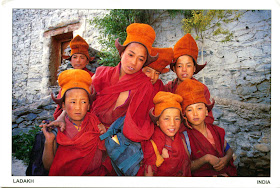Page
▼
March 14, 2013
0553 INDIA (Jammu and Kashmir) - Young gelugpas from Ladakh
Ladakh (Land of high passes) is the highest plateau of Kashmir (in nowadays divided between India, Pakistan and China) with much of it being over 3,000 m, spanning the Himalayan and Karakoram mountain ranges and the upper Indus River valley. In Middle Age, it constituted for long time an independent kingdom, constantly harassed by more powerful neighbors, Tibet, China, Mogul Empire or proper Kashmir. In 1842, Ladakh was incorporated into the Dogra state of Jammu and Kashmir, and at the time of the partition of India in 1947, the Dogra ruler signed the Instrument of Accession to India, so today Ladakh is part of the Indian state of Jammu and Kashmir. Influences were not only political but also religious, the region being in the area of contact between Buddhism and Islamism, the conflicts started in the 13th century, with the Islamic conquest of South Asia, continuing until today.
Ladakh has a population of about 260,000 which is a blend of many different ethnic groups, predominantly Tibetans, Monpas and Dards. Regarding the religion, the region's population is split roughly in half between the districts of Leh (77% Tibetan Buddhists) and Kargil (80% Muslims). Although there were many householder-yogis in Tibet, monasticism was the foundation of Buddhism there, but also in other regions, as Ladakh. I wrote here some things about the buddhist monks and their clothes, but the Tibetan monks differ in certain respects. They wear a shirt and a skirt instead of a one-piece robe, and a shawl-type robe may be worn as an outer layer.
Tibetan nuns, monks and lamas wear an enormous variety of robes, hats, capes, and even costumes, but the basic robe consist of these parts:
• dhonka - a wrap shirt with cap sleeves, usually maroon or maroon and yellow with blue piping.
• shemdap - a maroon skirt made with patched cloth and a varying number of pleats.
• chögu - something like a sanghati, a wrap made in patches and worn on the upper body, although sometimes it is draped over one shoulder like a kashaya robe. It is yellow and worn for certain ceremonies and teachings.
• zhen is similar to chögu, but maroon, and is for ordinary day-to-day wear.
• namjar is larger than the chögu, with more patches, and it is yellow and often made of silk. It is for formal ceremonial occasions.
The young monks in the picture wear zhen robes. Lama ("chief" or "high priest") is a title for a Tibetan teacher of the Dharma, the name being similar to the Sanskrit term guru. Today the title can be used as an honorific title, which designate a level of spiritual attainment and authority to teach, or may be part of a title such as Dalai Lama. From a confusion, the term "lama" is sometimes applied to Tibetan monks in general, as in this postcard. Actually they are gelugpas, members of the sect with the same name, also known as the Yellow Hat sect, a school founded by Je Tsongkhapa (1357–1419), a philosopher and Tibetan religious leader.
About the stamps
The first stamp was issued on January 8, 2013, with the occasion of Ghadar Movement Centenary, an organization founded by Punjabi Indians in the United States and Canada with the aim to liberate India from British rule.
The second stamp, depicting Sir Chandrasekhara Venkata Rāman, is part of the definitive set Builders of Modern India, about which I wrote here.
References
Ladakh - Wikipedia
Tibetan Buddhism - The Soka Gakkai Dictionary of Buddhism
The Buddha's Robe - About.com
sender: Sita Seshadri (direct swap)
sent from Mumbai (Maharashtra / India), on 05.03.2013
photo: Dorjay Angdus (Kaya)



No comments:
Post a Comment